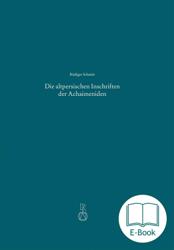In this book may be found a complete edition and German translation of the Old Persian texts of the mostly trilingual cuneiform inscriptions of the Persian kings from the Achaemenid dynasty. Only the minor corpora of vase inscriptions and those on seals and weights are passed over, because they are of only narrow historical meaning. The edition presents the transliterated and the transcribed texts in two columns next to each other and beneath them succinct annotations and the translation respectively, which tries to render the original wording as literally as possible. The book starts with a list of all the Achaemenid cuneiform inscriptions (also those written not in Old Persian script and language), that describes the texts in outline and includes the literature relevant for constituting and translating the texts in question.
For the first time since F. H. Weissbach, Die Keilinschriften der Achämeniden (1911), in this book may be found a complete edition and German translation of the Old Persian texts of the mostly trilingual cuneiform inscriptions of the Persian kings from the Achaemenid dynasty. The text (which is presented in transliterated and in ‘normalizing’ transcribed form) and the translation take into account the numerous new texts discovered during the 20th century in Susa, Persepolis and elsewhere as well as the progress made in constituting reliable and authentic texts and in their interpretation. Only the minor corpora of vase inscriptions and those on seals and weights are passed over, because they are of only narrow historical meaning. The edition presents the transliterated and the transcribed texts in two columns next to each other and beneath them succinct annotations and the translation respectively, which tries to render the original wording as literally as possible. The text is printed neither continuously nor line-for-line as on the original object, but it is broken up into paragraphs and then into short sections (phrases, sentences, clauses).
The book starts with a list of all the Achaemenid cuneiform inscriptions (also those written not in Old Persian script and language), that describes the texts in outline and includes the literature relevant for constituting and translating the texts in question.
In all, this edition is intended not only for scholars working in the fields of Iranian, Indo-Iranian, and Indo-European studies. It is addressed also to all scholars of Ancient History, Classical and Near Eastern Archaeology, Assyriology, Biblical Studies etc. not specialized, but interested in the Old Persiantexts and in the epigraphy of the Achaemenid period at all, and it will provide them with a reliable text for their studies.
Rüdiger Schmitt, from 1979 to 2004 Professor of Comparative Indo-European Philology and Indo-Iranian Studies at Saarland University in Saarbrücken, is born in Würzburg on June 1, 1939. He did his studies 1958–1965 in Würzburg, Erlangen and Saarbrücken, particularly with Manfred Mayrhofer. After studies on Indo-European poetical language, on the Greek and Armenian languages, he specialized on ancient Iranian languages, Old Persian epigraphy and, above all, on Iranian personal names.


 Table of Contents
Table of Contents